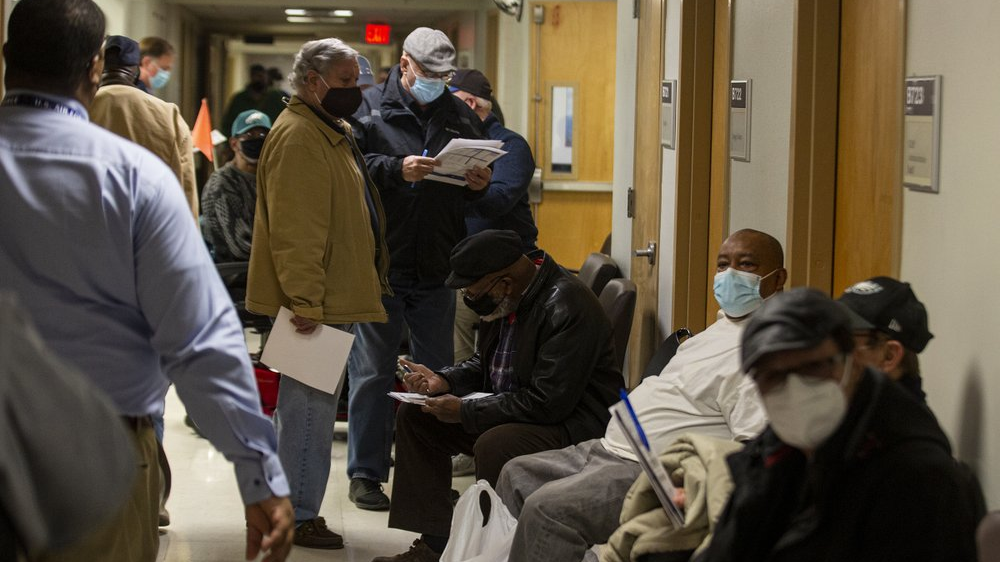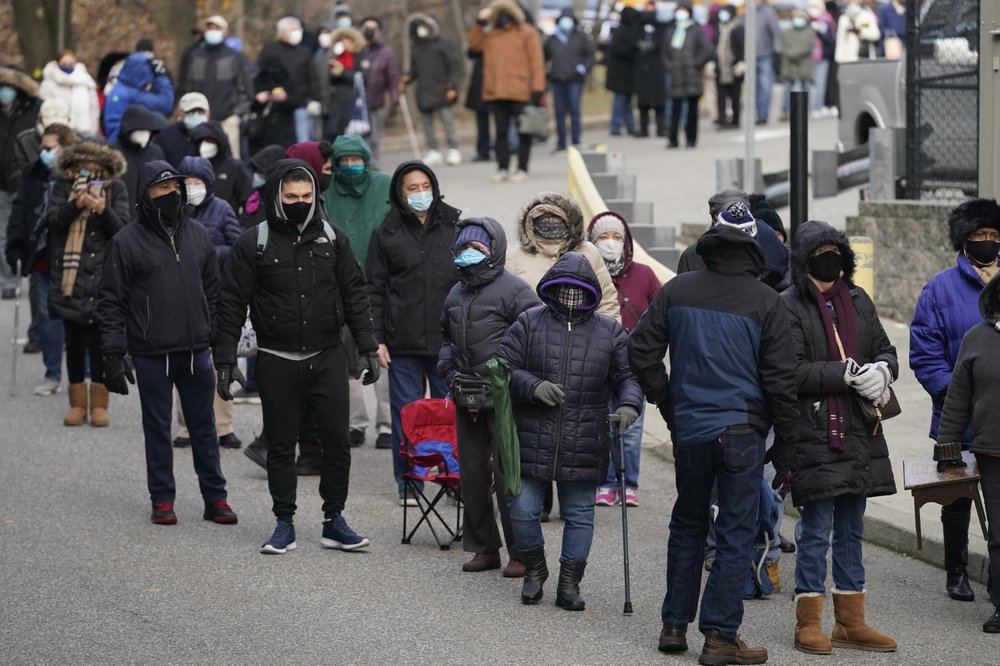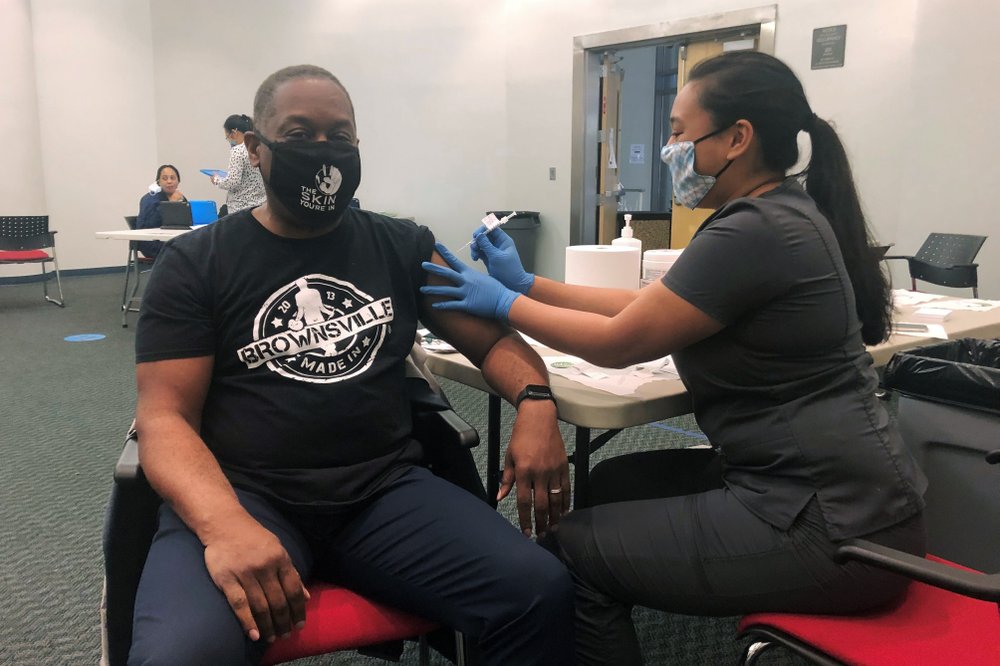
Veterans wait in line inside the VA Medical Center to receive COVID-19 vaccine, Philadelphia, U.S., January 23, 2021. /AP
Veterans wait in line inside the VA Medical Center to receive COVID-19 vaccine, Philadelphia, U.S., January 23, 2021. /AP
Data released by 17 states and two cities in the U.S. through January 25 revealed a severe racial gap in the nation's COVID-19 vaccination drive, as Black people in all places are getting inoculated at levels below their share of the general population, in some cases significantly below.
That is true even though they constitute an oversize percentage of the nation's healthcare workers, who were put at the front line for shots when the campaign began in mid-December 2020.
For example, in North Carolina, Black people make up 22 percent of the population and 26 percent of the healthcare workforce but only 11 percent of the vaccine recipients so far. White people, a category in which the state includes both Hispanic and non-Hispanic whites, are 68 percent of the population and 82 percent of those vaccinated.
In Maryland, Black people make up 30 percent of the population and 40 percent of the healthcare industry yet account for just 16 percent of the people vaccinated so far. White people, which in the state's data include both Hispanic and non-Hispanic whites, constitute 55 percent of the population and 67 percent of those who have gotten the shots. Hispanics of any race are 11 percent of the population and 5 percent of the vaccine recipients.

People wait in line for COVID-19 vaccine in Paterson, New Jersey, U.S., January 21, 2021. /AP
People wait in line for COVID-19 vaccine in Paterson, New Jersey, U.S., January 21, 2021. /AP
In Philadelphia, Black people are 40 percent of the population but just 14 percent of the people vaccinated so far. Hispanics are 15 percent of the population and 4 percent of the vaccine recipients.
In Chicago, Black people make up 30 percent of the population but only 15 percent of those vaccinated. With Hispanics, the numbers are 29 percent versus 17 percent.
Hispanic people also lagged behind in vaccinations, but their levels were somewhat closer to expectations in most places studied, because the group of people on average are younger than other Americans and vaccinations have yet to be thrown open to young people.
The gap is deeply troubling to some, given that the coronavirus has taken a disproportionate toll in terms of severe sickness and death on Black people in the U.S., where the scourge has killed over 430,000 Americans. Black, Hispanic and Native American people are dying from COVID-19 at almost three times the rate of white people, according to the Centers for Disease Control and Prevention (CDC).
Experts say several factors could be driving the emerging disparity, including deep distrust of the medical establishment among Black Americans because of a history of discriminatory treatment, inadequate access to the vaccine in Black neighborhoods and a digital divide that can make it difficult to get crucial information. Vaccination sign-ups are being done to a large degree online.
Some Black neighborhoods have nobody signed up to give shots.
"What we've heard over and over again: A lot of Black folks want to get it from their doctor or from their local clinic because that's where the trust is," Dr. Thomas Dobbs, Mississippi's health officer told the Associated Press.

Thomas LaVeist gets his first dose of a COVID-19 vaccine at Tulane University School of Public Health & Tropical Medicine, New Orleans, Louisiana, U.S., January 25, 2021. /AP
Thomas LaVeist gets his first dose of a COVID-19 vaccine at Tulane University School of Public Health & Tropical Medicine, New Orleans, Louisiana, U.S., January 25, 2021. /AP
To address mistrust, Thomas LaVeist, dean of the School of Public Health and Tropical Medicine at Tulane University in New Orleans, is recruiting notable Black Americans to help promote vaccination.
Although LaVeist gives credit to the Trump administration for supporting vaccine development, he said naming the project Operation Warp Speed was a "disastrous" choice because it seemed to emphasize speed, not careful scientific review.
"I completely understand the mistrust," said LaVeist, who had his first shot Monday. "But you have to consider the risk of COVID versus the risk of the vaccine. This is a devastating disease and it has disproportionately impacted Black Americans. That is what we do know."
Because of deportation fears, there is also mistrust among Latinos that is undercutting the vaccination drive, as well as a language barrier in many cases, according to activists.
The vaccine drive has been slower and more problem-plagued than expected. Many Americans of all races have had trouble getting shots because the supply is limited. Overall, about 7 percent of Americans have received at least one dose.
President Joe Biden is trying to bring more equity to the vaccine rollout. His administration is encouraging states to map and target vulnerable neighborhoods using tools such as the CDC's social vulnerability index, which incorporates data on race, poverty, crowded housing and other factors.
"We are going to take extra steps to get to the people hardest to reach, and that work is happening right now," said Dr. Marcella Nunez-Smith, the chair of Biden's COVID-19 equity task force.
Most states have yet to release any racial data on who has been vaccinated. Even in the states that provided breakdowns, the data is often incomplete, with many records missing details on race. However, the missing information would not be enough to change the general picture in most cases.
(With input from AP)

